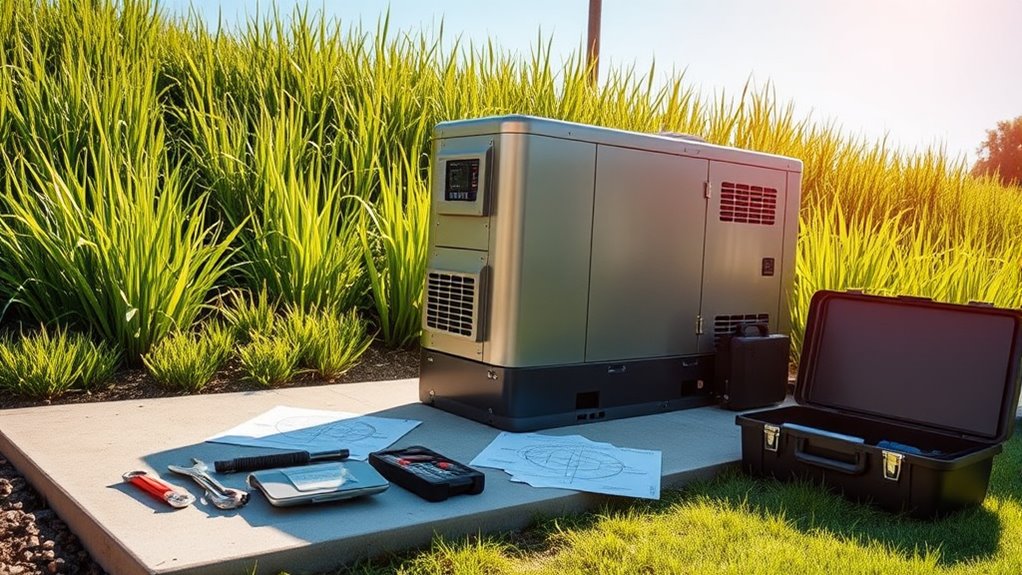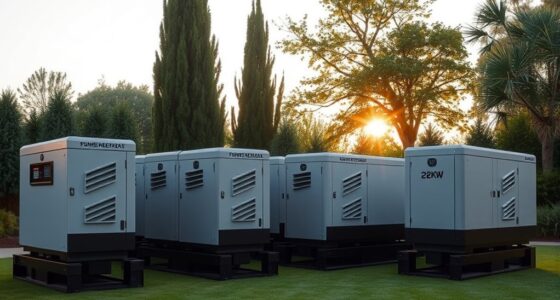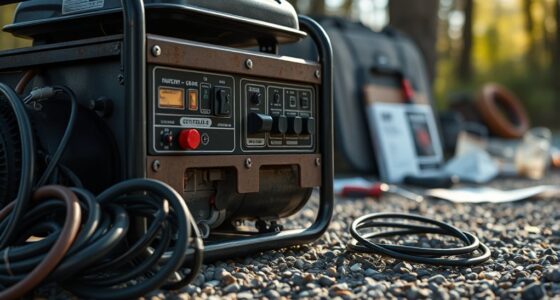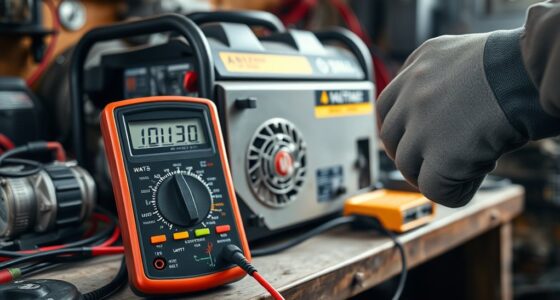When sizing your standby generator, it’s crucial to accurately add up your essential loads, accounting for both running and starting watts, especially for high-demand appliances. Oversizing wastes money, while undersizing risks overloads and outages. Future upgrades and proper load management also matter. If you skip these steps, your system won’t perform reliably or efficiently. Keep going to uncover the key insights pros wish you knew for ideal generator sizing.
Key Takeaways
- Accurately calculate total essential loads, including surge wattages, to ensure the generator can handle startup demands.
- Properly size the generator to match the combined running watts of critical appliances without over- or under-sizing.
- Consider future load additions to prevent under-capacity and costly replacements later.
- Avoid oversizing to reduce noise, fuel waste, and unnecessary costs; focus on optimal load management.
- Account for installation factors like location, noise restrictions, and surge capacity to maximize generator lifespan and performance.
Understanding Your Home’s Power Requirements
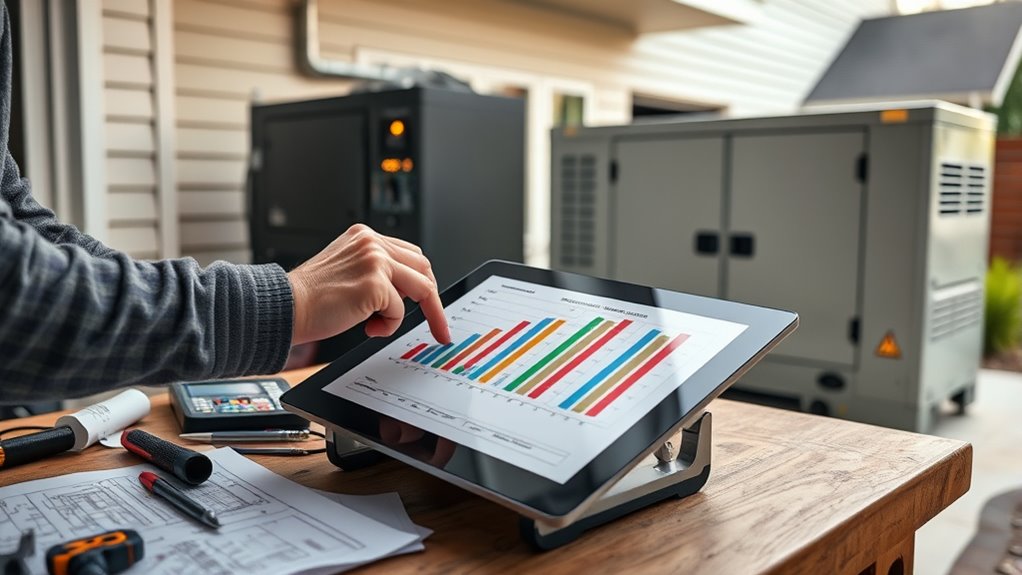
To properly size a standby generator, you first need to understand your home’s power requirements. Start by evaluating your electrical wiring system, noting how much capacity it can handle and which circuits are essential during a power outage. Your home’s insulation also plays a role, as well-insulated spaces may require less energy to heat or cool, affecting overall power needs. Make a list of critical appliances and systems, including HVAC, refrigerator, and lighting, then determine their wattage. Check your electrical wiring for any outdated or insufficient circuits that might limit your system’s capacity. Additionally, understanding your home’s energy efficiency can help optimize generator size and performance. By understanding these factors, you ensure your generator can adequately support your home’s needs without being oversized or undersized, providing reliable backup power when you need it most.
The Difference Between Starting and Running Watts
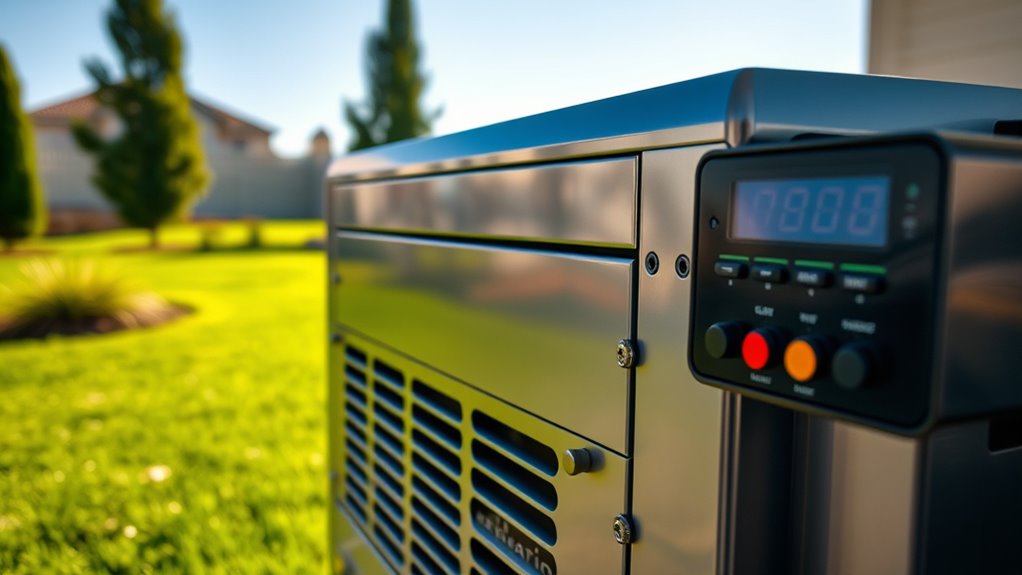
Understanding your home’s power needs is the first step, but it’s equally important to grasp how appliances draw power during startup. Starting watts refer to the surge of power needed when an appliance first turns on, often much higher than its running watts, which is the continuous power it consumes during operation. For example, a refrigerator may require 1,200 starting watts but only 200 running watts. When sizing your generator, consider these differences to ensure it can handle both startup surges and ongoing loads. Also, think about your transfer switch and its installation location; placing it correctly guarantees your generator can efficiently power appliances during startup without overloads. Knowing the distinction helps you select a generator that’s reliable and safe, avoiding costly under or over-sizing. Incorporating proper load management techniques can further optimize generator performance and longevity.
Common Mistakes When Selecting Generator Size

Choosing the right generator size is essential, but many people make common mistakes that can lead to underperformance or damage. One mistake is oversizing, which increases generator noise and costs, or undersizing, risking insufficient power. Another key error is ignoring the installation location; a noisy generator placed near living spaces can cause discomfort. Proper sizing involves understanding your load needs and considering factors like startup surges. Additionally, neglecting to account for projector-specific power demands can result in inadequate performance for home theater setups.
How to Calculate Your Emergency Power Needs

To accurately size your generator, start by identifying your essential loads—what must stay on during an outage. Next, determine the surge capacity needed for appliances that draw extra power when starting up. Finally, calculate how long your generator needs to run to keep your critical systems operational. Consulting paint sprayer reviews can also provide insight into the power requirements of various tools used in home improvement projects.
Assess Essential Loads
Evaluating your essential loads is the crucial first step in determining your emergency power needs. To guarantee your backup power covers what truly matters, identify key appliances and systems. Here’s how to start:
- List critical items like your refrigerator, sump pump, heating system, and lights.
- Check each device’s wattage or amperage to understand power consumption.
- Prioritize loads that keep your home safe and functional during outages.
- Sum up the wattages to find the total essential load requirement.
- Load calculation is vital for ensuring your generator is appropriately sized to meet your needs without overtaxing it.
Focusing on essential loads guarantees your backup power supports only what’s necessary, preventing over-sizing. This way, your generator can handle your critical needs without wasting capacity or fuel. Proper assessment ensures reliable backup power when you need it most.
Determine Surge Capacity
Understanding surge capacity is essential because many appliances draw substantially more power at startup than during normal operation. This power fluctuation can trip your generator if not properly accounted for. To determine your surge capacity, list all appliances and their startup wattages. Add the highest startup loads together to find the total surge requirement. This calculation relies on accurate appliance data to ensure your generator can handle these brief power spikes without overloads. Knowing your surge capacity helps prevent overloads during power fluctuations, ensuring your generator runs smoothly when you need it most.
Calculate Runtime Needs
Ever wonder how long your backup power can keep essential appliances running during an outage? To determine this, you need to calculate your runtime needs. First, list all critical devices and their wattage. Second, total their power consumption to find your overall load. Third, consider your generator’s efficiency—more efficient models use less fuel for the same output. Fourth, factor in fuel management; knowing your tank size helps estimate how long your generator can run before refueling. This process guarantees your generator is sized correctly to meet your emergency power needs without wasting fuel or overloading. Additionally, understanding payment solutions can streamline your maintenance and service scheduling, ensuring your generator is always ready when needed. By understanding these factors, you’ll keep your power running smoothly when it counts most.
The Impact of Future Additions on Generator Sizing

When planning your standby generator, considering future additions is essential because these changes can substantially influence the system’s required capacity. If you anticipate future expansion, such as adding new appliances or systems, you need to account for these additional loads now. Failing to do so may result in under-sizing your generator, which can lead to insufficient power during outages. On the other hand, oversizing to accommodate future needs might increase upfront costs unnecessarily. To strike a balance, evaluate your long-term plans and estimate the power demands of potential additions. This proactive approach helps ensure your generator can handle future loads without being excessively oversized, providing reliable backup power and optimizing your investment. Additionally, understanding your home’s electrical load and how UST projectors and ALR screens can impact power needs is crucial for effective generator sizing.
Why Oversizing or Undersizing Can Cost You More

If your generator is too large or too small, you’ll end up wasting fuel or risking equipment damage. Oversizing leads to higher fuel costs and unnecessary wear, while undersizing can cause frequent breakdowns and reduced lifespan. Finding the right size helps you save money and keep your system reliable. Proper bedroom design ensures a comfortable and functional space, which parallels choosing the correct generator size to optimize performance and efficiency.
Increased Fuel Consumption
Choosing the right size for your standby generator is crucial because both oversizing and undersizing can lead to higher fuel costs. When your generator isn’t properly sized, it affects fuel efficiency and increases fuel consumption. Here’s what to watch for:
- Oversized units run at low loads, wasting fuel by operating inefficiently.
- Undersized models strain to meet power needs, consuming more fuel in the process.
- The type of fuel your generator uses impacts efficiency—some fuel types offer better mileage.
- Proper sizing ensures your generator runs at ideal load, conserving fuel and reducing costs.
- Regular maintenance and inspections can help optimize fuel efficiency and prolong your generator’s lifespan.
Equipment Longevity Risks
Properly sizing your standby generator isn’t just about fuel efficiency—it also directly impacts the equipment’s lifespan. An undersized generator strains to meet your power needs, leading to frequent overloads and increased wear. Conversely, an oversized unit runs more often than necessary, which can cause unnecessary generator noise and accelerate component fatigue. The installation location plays a vital role here; placing a large generator close to living spaces can amplify noise issues and shorten its lifespan due to constant vibrations. Proper sizing ensures the generator operates within ideal parameters, reducing stress, minimizing noise disturbances, and extending its durability. Investing in the right size now saves you money and hassle in the long run, preventing premature replacements and costly repairs.
The Role of Load Management in Sizing Decisions
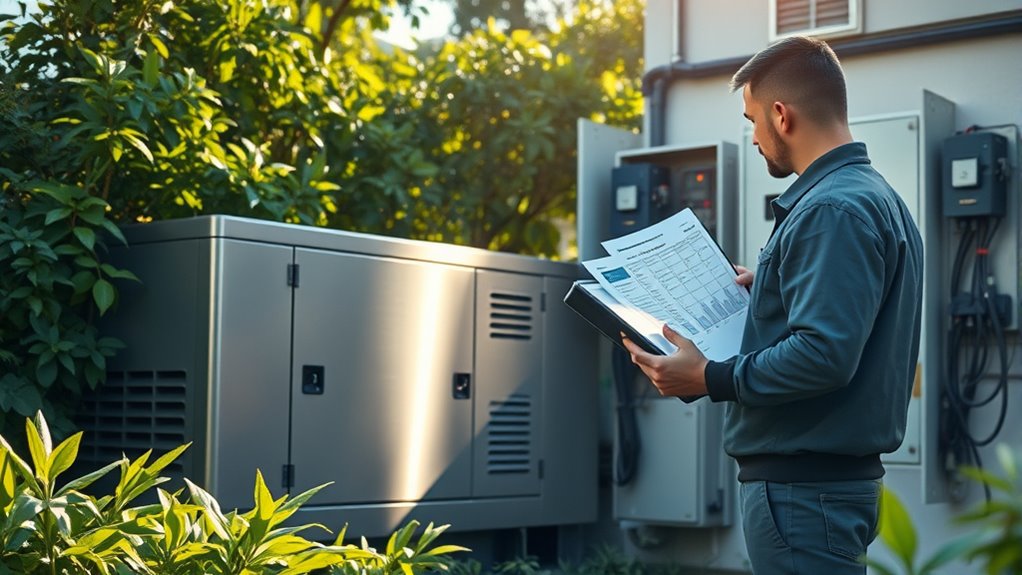
Load management plays a crucial role in determining the appropriate size of a standby generator. By implementing strategies like load prioritization and demand reduction, you can optimize your generator’s performance. Here’s how:
- Identify critical loads that must run during outages.
- Schedule non-essential systems to minimize demand.
- Use load shedding to temporarily disconnect non-essentials.
- Balance your load to prevent overloading and ensure reliable power.
This approach helps you avoid unnecessary generator capacity, saving costs and prolonging equipment life. Proper load management ensures your generator can handle essential demands without being oversized, which leads to better efficiency and fewer maintenance issues. Ultimately, smart load management makes your backup system more dependable and tailored to your specific needs.
Considering Fuel Efficiency and Runtime

Choosing the right fuel type affects your generator’s efficiency, runtime, and how well it balances power needs. Gasoline models may need more maintenance but can be convenient for smaller setups. Understanding these factors helps you select a generator that keeps running when you need it most.
Fuel Type Impacts Efficiency
The type of fuel you select substantially influences a standby generator’s efficiency and runtime. Different fuels offer varying fuel economy and storage needs, impacting your overall setup. For example:
- Gasoline is easy to store but burns quickly, reducing runtime.
- Diesel provides better fuel economy and longer operation but requires larger storage tanks.
- Propane has clean-burning benefits, with good fuel efficiency and flexible storage options.
- Natural gas offers consistent fuel supply and minimal storage concerns but depends on utility connections.
Choosing the right fuel type depends on your priorities—whether that’s maximizing runtime, minimizing storage, or optimizing fuel economy. Understanding these differences helps you make smarter decisions for reliable, efficient backup power.
Runtime and Power Balance
Balancing runtime and power output is essential when selecting a standby generator, as enhancing one often impacts the other. A generator running at a lower load operates more fuel-efficiently, extending runtime and saving you money. Proper load management ensures you don’t overburden the unit, which can reduce fuel efficiency and shorten runtime. To find the right balance, consider your typical power needs and choose a generator that can handle your essential loads comfortably. Running the generator at or near its peak load maximizes fuel efficiency and ensures longer operation during outages. Avoid overloading the generator, which strains the system and consumes more fuel. By managing your load wisely, you’ll achieve a better runtime without sacrificing power output or efficiency.
Maintenance for Gasoline Models
Have you kept up with regular maintenance to maximize your gasoline generator’s fuel efficiency and runtime? Proper upkeep can extend your generator’s lifespan and ensure it runs smoothly when needed. Here’s what to focus on:
- Check your fuel tank regularly and keep it clean to prevent clogs and fuel contamination.
- Schedule oil changes as recommended to maintain engine performance.
- Inspect and replace air filters to improve fuel combustion.
- Test run your generator periodically to identify issues early.
Consulting Professionals for Accurate Sizing

Consulting with experienced professionals is vital to guarantee your standby generator is accurately sized for your needs. They can assess your power requirements, ensuring your generator can handle your essential loads without over- or under-sizing. Proper generator installation also depends on expert guidance to optimize performance and safety. Professionals consider factors like startup currents and continuous loads, which are fundamental for reliable operation. Additionally, they can recommend solutions for noise reduction, helping you select a generator that minimizes disruption. Accurate sizing prevents issues like frequent overloads or unnecessary fuel consumption. Relying on experts ensures your system provides dependable backup power, enhances safety, and maintains efficiency, giving you peace of mind during outages. Ultimately, professional consultation saves you time, money, and potential headaches down the line.
Tips for Proper Maintenance and Performance Verification
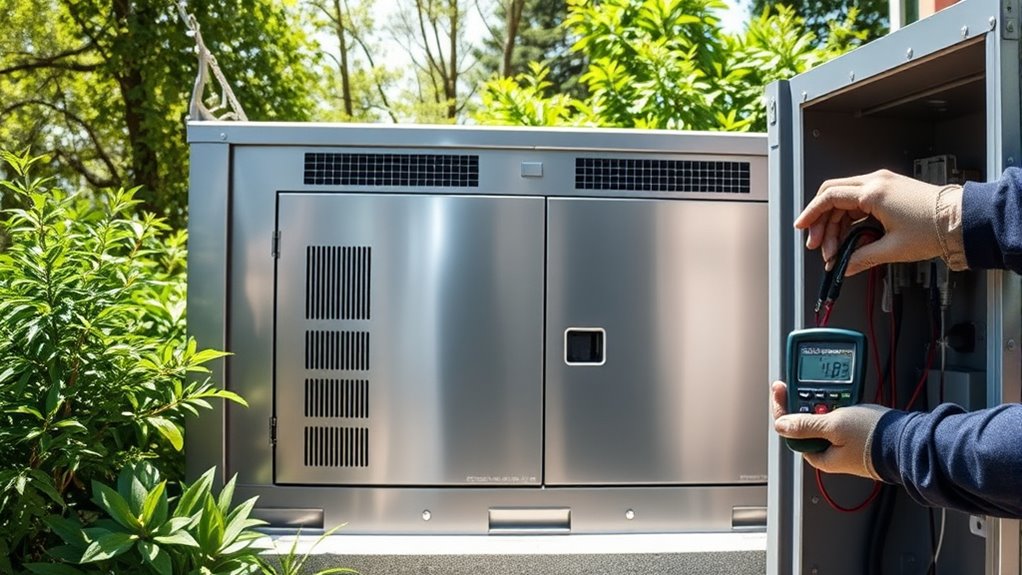
Ensuring your standby generator operates reliably requires regular maintenance and verification of its performance. First, check the generator noise levels during operation; excessive noise may indicate a problem or poor installation location. Second, schedule routine inspections and oil changes to keep components running smoothly. Third, test the automatic transfer switch monthly to ensure seamless power transfer during outages. Fourth, verify the installation location minimizes noise disturbance and allows proper ventilation, which aids in performance and longevity. Keep the area around your generator clear of debris, and listen for unusual sounds that could signal issues. Regular maintenance not only prolongs your generator’s life but also guarantees it performs when you need it most, providing peace of mind during outages.
Frequently Asked Questions
How Does Climate Impact Generator Sizing Needs?
Did you know that extreme temperatures can increase generator fuel consumption by up to 20%? Climate considerations and environmental factors play a vital role in sizing your generator. Hotter climates demand larger units to handle increased cooling loads, while colder environments require models capable of starting reliably in low temperatures. Ignoring these factors may lead to inadequate power during outages, so always tailor your generator size to your local climate conditions.
Can Generator Size Affect Home Insurance Policies?
Your home insurance policies can be affected by generator size, especially if maintenance isn’t kept up or fuel efficiency drops. Larger generators may require more frequent maintenance, and if neglected, insurers could see this as a risk. Properly sized generators that are well maintained ensure reliable backup power, potentially reducing your premiums. Always check with your insurer to understand how your generator’s size and upkeep influence your coverage.
What Are the Long-Term Cost Implications of Sizing Errors?
Sizing errors can lead to significant long-term costs. If your generator is too small, you’ll face frequent breakdowns and higher maintenance, increasing expenses over time. Conversely, oversizing results in unnecessary energy use and higher initial costs. Accurate cost estimation relies on proper sizing, so prioritizing sizing accuracy helps you avoid these pitfalls. Investing in the right size ensures reliable power, lower operational costs, and better long-term savings.
How Do Electrical Code Updates Influence Generator Selection?
Oh, the thrill of code updates! You’ll want to pick a generator with a compliant transfer switch that meets new standards, ensuring smooth operation. Ignoring these changes might lead to penalties or safety hazards. Plus, new codes often emphasize fuel efficiency, so choose a model that conserves fuel and cuts costs. Staying current keeps your generator legal, reliable, and eco-friendly—because who doesn’t want to impress their neighbors?
Is There a Recommended Safety Margin for Generator Sizing?
Yes, there’s a recommended safety margin when sizing your generator. Aim for about 20-25% extra capacity to account for generator efficiency and potential load increases. This guarantees your system handles peak demands without overloading. Remember, larger capacity might mean more maintenance frequency, so balance size with efficiency. Properly sizing with a safety margin helps prevent unexpected outages and keeps your generator running smoothly during power surges.
Conclusion
By understanding your home’s power needs and avoiding common pitfalls, you can select a standby generator that quietly supports your lifestyle. Proper sizing ensures reliable backup power without unnecessary expense or noise. Don’t hesitate to seek expert advice—you’ll find it’s a small step that makes a big difference. With the right approach, your generator becomes a trusted partner, quietly safeguarding your comfort when it matters most.
